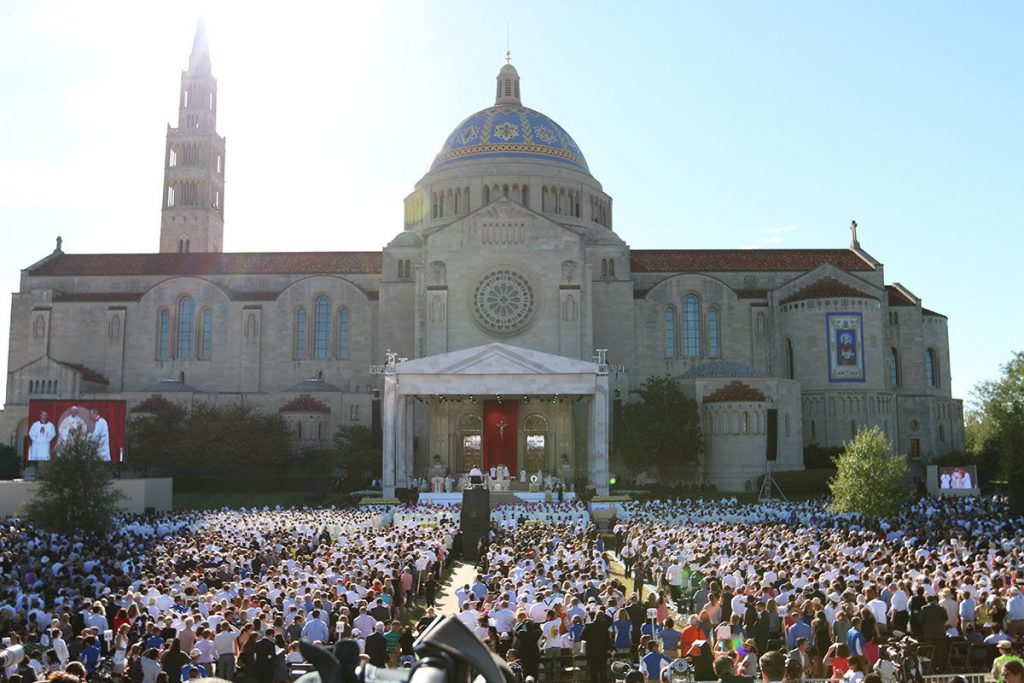WASHINGTON — The Church is heir to bold missionaries who risked their own well being to share the Gospel of Jesus Christ, Pope Francis said.
“We are indebted to a tradition, a chain of witnesses who have made it possible for the good news of the Gospel to be, in every generation, both ‘good’ and ‘news,’” he said before more than 25,000 who gathered outside the Basilica of the National Shrine of the Immaculate Conception Sept. 23 for the Mass of Canonization of St. Junípero Serra.
St. Junípero is the first saint to be canonized on U.S. soil.
The pope underscored how Father Serra left his native land to evangelize those already living on the North American continent, “learning and valuing their particular customs and ways of life.”
Vincent Medina read the first reading, from the Book of the Prophet Isaiah, in the Chochenyo Native American Language. It is the language of the Ohlone.
St. Junípero “learned how to bring to birth and nurture God’s life in the faces of everyone he met,” the pope said during his Spanish-language homily. The Mass was largely celebrated in Spanish, though it also featured songs and readings in other languages.
“He made them his brothers and sisters,” Pope Francis said of how the saint identified with the native people. “Junípero sought to defend the dignity of the native community, to protect it from those who had mistreated and abused it.”
This abuse, the pope said, has left scars that still trouble many, likely referring to the abuse of Native Americans through colonization.
The Native American population in California dropped to 20,000 from an estimated 330,000 in 150 years. Historians typically break this time into three periods: The Missionary Period (1769-1821), the Mexican Period (1822-1848) and the American Period (beginning in 1848).
The largest decrease in population took place after the missionary period, after Father Serra’s death in 1784. There were many abuses during the California Gold Rush and the first California governor called for the elimination of Native Americans.
St. Junípero stood up against the government on behalf of the native peoples.
“Father Serra had a motto which inspired his life and work, a saying he lived his life by: ‘¬°Siempre adelante!’ Keep moving forward!” the pope said.
“For him, this was the way to continue experiencing the joy of the Gospel, to keep his heart from growing numb, from being anesthetized,” he said. “Today, like him, may we be able to say: Forward! Let’s keep moving forward!”
A group of 40 from Querétaro, Mexico, traveled to Washington, DC, for the Mass of Canonization. Father Serra established five missions in Querétaro — the Missions of Sierra Gorda.
“His motto of ‘Always forward’ motivates us,” said Graciela Rubio, noting that the group came after being invited by the Archdiocese of Washington. “Evangelization is changing, our ways of communicating are changing, but we have to keep looking forward.”
Lucy Rivera, from Washington, DC, said Pope Francis has captured the world’s attention.
“His message of being merciful to the poor and the needy needs to be heard in all countries,” she said.
Morton Zabala, who came from the Diocese of Monterrey, California, shared that his family lives close to San Carlos Borromeo del Carmelo Mission, home of the Shrine of St. Junípero Serra.
“Just being here was… I can’t describe it,” he said, noting that he served as an extraordinary minister of the Holy Eucharist. “To be there, see Pope Francis, the way he really is. He’s so humble and simple. And that comes out in his presence.”
Merle Talens, who came from the Archdiocese of San Francisco, said the long wait was worth it.
“We know about Father Serra because we’re in California. I’m happy he’s a saint,” she said. “It’s a blessing that we are here during his canonization.”
Before Pope Francis declared Father Serra a saint, a biography of the missionary’s life was read.
In 1713, Father Serra was born on Mallorca, a small island off the coast of Spain. After his ordination as a Franciscan priest, he began teaching philosophy at the Lullian University at Palma.
But at 36, the priest felt a call to missionary service. He crossed the Atlantic to begin evangelizing in North America. He landed in Mexico and founded missions there, as well as in California.
Many of Father Serra’s California missions have become major cities, including San Diego, San Francisco, Santa Barbara and Santa Clara.
Father Serra confirmed more than 5,000 individuals, largely Native Americans, during his 14 years of mission work between 1770 and 1784. That’s despite suffering from a cancerous leg and asthma.
His canonization was on the Feast of Padre Pio of Pietrelcina, a saint who also suffered physical ailments throughout his life.
“Jesus sends his disciples out to all nations. To every people. We too were part of all those people of two thousand years ago,” the pope said in his homily.
“Jesus did not provide a short list of who is, or is not, worthy of receiving his message, his presence. Instead, he always embraced life as he saw it,” he said. “In faces of pain, hunger, sickness and sin. In faces of wounds, of thirst, of weariness, doubt and pity. … It made no difference whether it was dirty, unkempt, broken. Jesus said: Go out and tell the good news to everyone.”

